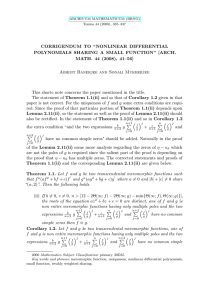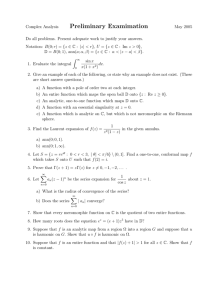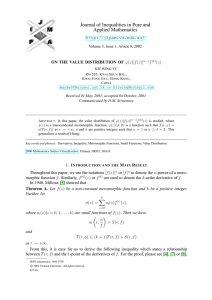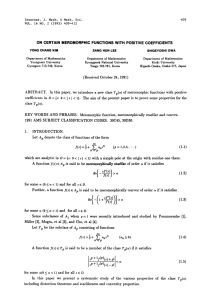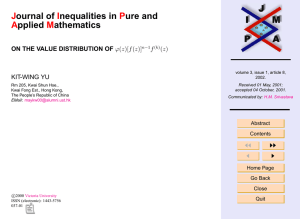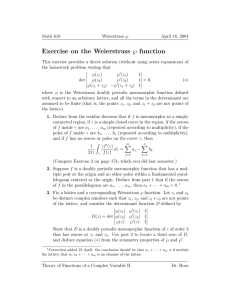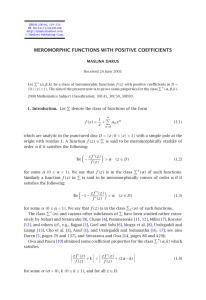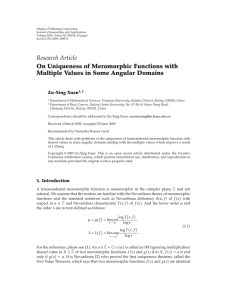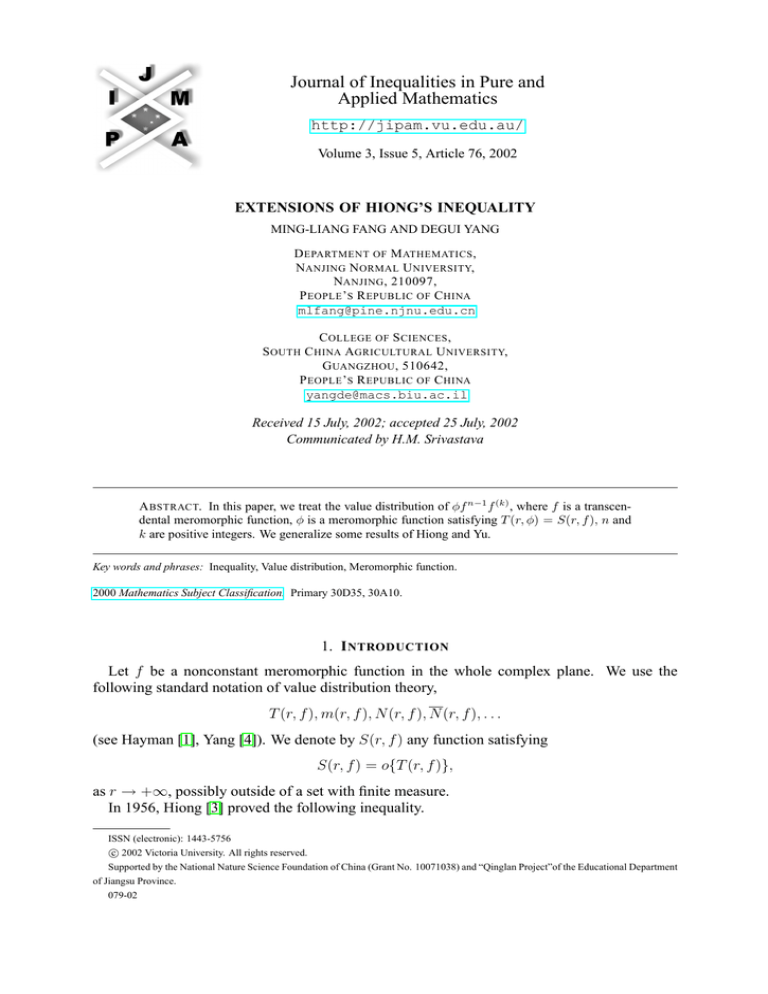
Journal of Inequalities in Pure and
Applied Mathematics
http://jipam.vu.edu.au/
Volume 3, Issue 5, Article 76, 2002
EXTENSIONS OF HIONG’S INEQUALITY
MING-LIANG FANG AND DEGUI YANG
D EPARTMENT OF M ATHEMATICS ,
NANJING N ORMAL U NIVERSITY,
NANJING , 210097,
P EOPLE ’ S R EPUBLIC OF C HINA
mlfang@pine.njnu.edu.cn
C OLLEGE OF S CIENCES ,
S OUTH C HINA AGRICULTURAL U NIVERSITY,
G UANGZHOU , 510642,
P EOPLE ’ S R EPUBLIC OF C HINA
yangde@macs.biu.ac.il
Received 15 July, 2002; accepted 25 July, 2002
Communicated by H.M. Srivastava
A BSTRACT. In this paper, we treat the value distribution of φf n−1 f (k) , where f is a transcendental meromorphic function, φ is a meromorphic function satisfying T (r, φ) = S(r, f ), n and
k are positive integers. We generalize some results of Hiong and Yu.
Key words and phrases: Inequality, Value distribution, Meromorphic function.
2000 Mathematics Subject Classification. Primary 30D35, 30A10.
1. I NTRODUCTION
Let f be a nonconstant meromorphic function in the whole complex plane. We use the
following standard notation of value distribution theory,
T (r, f ), m(r, f ), N (r, f ), N (r, f ), . . .
(see Hayman [1], Yang [4]). We denote by S(r, f ) any function satisfying
S(r, f ) = o{T (r, f )},
as r → +∞, possibly outside of a set with finite measure.
In 1956, Hiong [3] proved the following inequality.
ISSN (electronic): 1443-5756
c 2002 Victoria University. All rights reserved.
Supported by the National Nature Science Foundation of China (Grant No. 10071038) and “Qinglan Project”of the Educational Department
of Jiangsu Province.
079-02
2
M ING - LIANG FANG
AND
D EGUI YANG
Theorem 1.1. Let f be a non-constant meromorphic function; let a, b and c be three finite
complex numbers such that b 6= 0, c 6= 0 and b 6= c; and let k be a positive integer. Then
1
1
1
T (r, f ) ≤ N r,
+ N r, (k)
+ N r, (k)
f −a
f −b
f −c
1
− N r, (k+1) + S(r, f ).
f
Recently, Yu [5] extended Theorem 1.1 as follows.
Theorem 1.2. Let f be a non-constant meromorphic function; and let b and c be two distinct
nonzero finite complex numbers; and let n, k be two positive integers. If φ(6≡ 0) is a meromorphic function satisfying T (r, φ) = S(r, f ), n = 1 or n ≥ k + 3, then
1
1
1
1
(1.1) T (r, f ) ≤ N r,
+
N r, n−1 (k)
+ N r, n−1 (k)
f
n
φf f − b
φf f − c
1
1
−
N (r, f ) + N r,
+ S(r, f ).
n
(φf n−1 f (k+1) )0
If f is entire, then (1.1) is valid for all positive integers n(6= 2).
In [5], the author expected that (1.1) is also valid for n = 2 if f is entire.
In this note, we prove that (1.1) is valid for all positive integers n even if f is meromorphic.
Theorem 1.3. Let f be a non-constant meromorphic function; and let b and c be two distinct
nonzero finite complex numbers; and let n, k be two positive integers. If φ(6≡ 0) is a meromorphic function satisfying T (r, φ) = S(r, f ), then
1
1
1
1
(1.2) T (r, f ) ≤ N r,
+
N r, n−1 (k)
+ N r, n−1 (k)
f
n
φf f − b
φf f − c
1
1
− N (r, f ) −
(k − 1)N (r, f ) + N r,
+ S(r, f ).
n
(φf n−1 f (k+1) )0
In [6], the author proved
Theorem 1.4. Let f be a transcendental meromorphic function; and let n be a positive integer.
Then either f n f 0 − a or f n f 0 + a has infinitely many zeros, where a(6≡ 0) is a meromorphic
function satisfying T (r, a) = S(r, f ).
In this note, we will prove
Theorem 1.5. Let f be a transcendental meromorphic function; and let n be a positive integer.
Then either f n f 0 − a or f n f 0 − b has infinitely many zeros, where a(6≡ 0) and b(6≡ 0) are two
meromorphic functions satisfying T (r, a) = S(r, f ) and T (r, b) = S(r, f ).
2. P ROOF OF T HEOREMS
For the proofs of Theorem 1.3 and 1.5, we require the following lemmas.
Lemma 2.1. [2]. If f is a transcendental meromorphic function and K > 1, then there exists a
set M (K) of upper logarithmic density at most
δ(K) = min{(2eK−1 − 1)−1 , (1 + e(K − 1)) exp(e(1 − K))}
such that for every positive integer k,
(2.1)
T (r, f )
≤ 3eK.
(k) )
r→∞,r ∈M
/ (K) T (r, f
lim sup
J. Inequal. Pure and Appl. Math., 3(5) Art. 76, 2002
http://jipam.vu.edu.au/
E XTENSIONS OF H IONG ’ S INEQUALITY
3
Lemma 2.2. If f is a transcendental meromorphic function and φ(6≡ 0) is a meromorphic
function satisfying T (r, φ) = S(r, f ). Then φf n−1 f (k) 6≡ constant for every positive integer n.
Proof. Suppose that φf n−1 f (k) ≡ constant. If n = 1, then φf (k) ≡ constant. Therefore,
T (r, f (k) ) = S(r, f ), which implies that
T (r, f )
= ∞.
(k) )
r→∞,r ∈M
/ (K) T (r, f
lim sup
This is contradiction to Lemma 2.1.
If n ≥ 2, then T (r, f n−1 f (k) ) = S(r, f ). On the other hand,
f
n−1 (k)
nT (r, f ) ≤ T (r, f f ) + T r, (k) + S(r, f )
f
f (k)
n−1 (k)
≤ T (r, f f ) + T r,
+ S(r, f )
f
f (k)
n−1 (k)
≤ T (r, f f ) + N r,
+ S(r, f )
f
1
≤ T (r, f n−1 f (k) ) + N (r, ) + N (r, f n−1 f (k) ) + S(r, f )
f
n−1 (k)
≤ 2T (r, f f ) + T (r, f ) + S(r, f ).
2
Hence T (r, f ) ≤ n−1
T (r, f n−1 f (k) ) + S(r, f ), Therefore, T (r, f ) = S(r, f ), which is a contradiction. Which completes the proof of this lemma.
Lemma 2.3. [1]. If f is a meromorphic function, and a1 , a2 , a3 are distinct meromorphic functions satisfying T (r, aj ) = S(r, f ) for j = 1, 2, 3. Then
T (r, f ) ≤
3
X
j=1
N
1
r,
f − aj
+ S(r, f ).
Proof of Theorem 1.3. By Lemma 2.2, we have φf n−1 f (k) 6≡ constant if n and k are positive
integers. By (4.17) of [1], we have
1
1
1
(2.2)
m r, n + m r, n−1 (k)
+ m r, n−1 (k)
f
φf f − b
φf f − c
1
f (k)
1
≤ m r, n−1 (k) + m r,
+ m r, n−1 (k)
φf f
f
φf f − b
1
+ m r, n−1 (k)
+ S(r, f )
φf f − c
1
1
≤ m r, n−1 (k) + m r, n−1 (k)
φf f
φf f − b
1
+ m r, n−1 (k)
+ S(r, f )
φf f − c
1
+ S(r, f )
≤ m r,
(φf n−1 f (k) )0
J. Inequal. Pure and Appl. Math., 3(5) Art. 76, 2002
http://jipam.vu.edu.au/
4
M ING - LIANG FANG
≤ T (r, (φf
n−1 (k) 0
))−N
f
AND
r,
D EGUI YANG
1
+ S(r, f )
(φf n−1 f (k) )0
1
n−1 (k)
+ S(r, f )
≤ T (r, φf f ) + N (r, f ) − N r,
(φf n−1 f (k) )0
By (2.2), we have
T (r, f n ) + T (r, φf n−1 f (k) )
1
1
1
+ N r, n−1 (k)
≤ N r, n + N r, n−1 (k)
f
φf f − b
φf f − c
1
+ N (r, f ) − N r,
+ S(r, f ).
(φf n−1 f (k) )0
Therefore,
1
1
nT (r, f ) ≤ nN
+ N r, n−1 (k)
+ N r, n−1 (k)
φf f − b
φf f − c
1
− N (r, f n−1 f (k) ) + S(r, f )
+ N (r, f ) − N r,
(φf n−1 f (k) )0
1
1
1
≤ nN r,
+ N r, n−1 (k)
+ N r, n−1 (k)
f
φf f − b
φf f − c
1
− nN (r, f ) − (k − 1)N (r, f ) − N r,
+ S(r, f ),
(φf n−1 f (k) )0
1
r,
f
thus we get (1.2). This completes the proof of Theorem 1.3.
Proof of Theorem 1.5. By Nevanlinna’s first fundamental theorem, we have
0 f
2T (r, f ) = T r, f f · 0
f
f
0
≤ T (r, f f ) + T r, 0 + S(r, f )
f
f0
0
≤ T (r, f f ) + T r,
+ S(r, f )
f
f0
0
≤ T (r, f f ) + N r,
+ S(r, f )
f
1
0
= T (r, f f ) + N r,
+ N (r, f ) + S(r, f )
f
1
≤ T (r, f f 0 ) + T (r, f ) + N (r, f f 0 ) + S(r, f ).
3
Thus we get
4
T (r, f ) ≤ T (r, f f 0 ) + S(r, f ).
3
Hence we get T (r, a) = S(r, f f 0 ) and T (r, b) = S(r, f f 0 ).
J. Inequal. Pure and Appl. Math., 3(5) Art. 76, 2002
http://jipam.vu.edu.au/
E XTENSIONS OF H IONG ’ S INEQUALITY
5
By Lemma 2.3, we have
1
1
T (r, f f ) ≤ N (r, f ) + N r, 0
+ N r, 0
+ S(r, f f 0 )
ff − a
ff − b
1
1
1
0
+ N r, 0
+ S(r, f f 0 ).
≤ N (r, f f ) + N r, 0
ff − a
ff − b
3
Hence we get
1
1
3
N r, 0
+ N r, 0
+ S(r, f f 0 ).
T (r, f ) ≤
ff − a
ff − b
2
0
0
Thus we know that either f f − a or f f − b has infinitely many zeros.
0
R EFERENCES
[1] W.K. HAYMAN, Meromorphic Functions, Clarendon Press, Oxford, 1964.
[2] W.K. HAYMAN AND J. MILES, On the growth of a meromorphic function and its derivatives,
Complex Variables, 12(1989), 245–260.
[3] K.L. HIONG, Sur la limitation de T (r, f ) sans intervention des pôles, Bull. Sci. Math., 80 (1956),
175–190.
[4] L. YANG, Value Distribution Theory, Springer-Verlag, Berlin, 1993.
[5] K.W. YU, On the distribition of φ(z)f n−1 (z)f (k) (z), J. of Ineq. Pure and Appl. Math., 3(1) (2002),
Article 8. [ONLINE: http://jipam.vu.edu.au/v3n1/037_01.html]
[6] K.W. YU, A note on the product of a meromorphic function and its derivative, Kodai Math. J., 24(3)
(2001), 339–343.
J. Inequal. Pure and Appl. Math., 3(5) Art. 76, 2002
http://jipam.vu.edu.au/

![Mathematics 414 2003–04 Exercises 5 [Due Monday February 16th, 2004.]](http://s2.studylib.net/store/data/010415766_1-b65af2bb66ab8e422354912dcedcb6a6-300x300.png)



